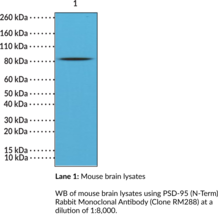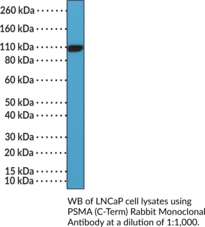Cayman
Showing 36601–36750 of 45550 results
-
PSB-12379 is an inhibitor of ecto-5’-nucleotidase (CD73; Kis = 2.21 and 9.03 nM for the recombinant human and rat enzyme, respectively).{50087} It is selective for CD73 over human nucleoside triphosphate diphosphohydrolase 1 (NTPDase 1), -2, and -3, ectonucleotide pyrophosphatase/phosphodiesterase family member 1 (ENPP1), -2, and -3 (Kis = >10,000 nM for all), as well as the purinergic P2Y1 and P2Y12 receptors at 10 µM. PSB-12379 inhibits CD73 in isolated human serum with a Ki value of 18.8 nM.
Brand:CaymanSKU:28446 - 1 mgAvailable on backorder
PSB-12379 is an inhibitor of ecto-5’-nucleotidase (CD73; Kis = 2.21 and 9.03 nM for the recombinant human and rat enzyme, respectively).{50087} It is selective for CD73 over human nucleoside triphosphate diphosphohydrolase 1 (NTPDase 1), -2, and -3, ectonucleotide pyrophosphatase/phosphodiesterase family member 1 (ENPP1), -2, and -3 (Kis = >10,000 nM for all), as well as the purinergic P2Y1 and P2Y12 receptors at 10 µM. PSB-12379 inhibits CD73 in isolated human serum with a Ki value of 18.8 nM.
Brand:CaymanSKU:28446 - 10 mgAvailable on backorder
PSB-12379 is an inhibitor of ecto-5’-nucleotidase (CD73; Kis = 2.21 and 9.03 nM for the recombinant human and rat enzyme, respectively).{50087} It is selective for CD73 over human nucleoside triphosphate diphosphohydrolase 1 (NTPDase 1), -2, and -3, ectonucleotide pyrophosphatase/phosphodiesterase family member 1 (ENPP1), -2, and -3 (Kis = >10,000 nM for all), as well as the purinergic P2Y1 and P2Y12 receptors at 10 µM. PSB-12379 inhibits CD73 in isolated human serum with a Ki value of 18.8 nM.
Brand:CaymanSKU:28446 - 5 mgAvailable on backorder
PSB-603 is an antagonist of the adenosine A2B receptor (Ki = 0.553 nM).{42518} It is selective for adenosine A2B over A1, A2A, and A3 receptors (Kis = >10,000 nM). It reduces intracellular calcium concentrations in Jurkat T cells expressing the human A2B receptor (IC50 = 1.13 nM). PSB-603 reduces Zika viral plaque formation (IC50 = 43.8 nM) without affecting cell viability of A549 cells when used at concentrations up to 1 µM.{42519} In vivo, PSB-603 (0.25 µg/head, i.p.) delays tumor growth and reduces tumor volume and the number of pulmonary metastases in the B16 mouse model of melanoma via inhibition of induction of regulatory T cells.{42520}
Brand:CaymanSKU:25637 - 1 mgAvailable on backorder
PSB-603 is an antagonist of the adenosine A2B receptor (Ki = 0.553 nM).{42518} It is selective for adenosine A2B over A1, A2A, and A3 receptors (Kis = >10,000 nM). It reduces intracellular calcium concentrations in Jurkat T cells expressing the human A2B receptor (IC50 = 1.13 nM). PSB-603 reduces Zika viral plaque formation (IC50 = 43.8 nM) without affecting cell viability of A549 cells when used at concentrations up to 1 µM.{42519} In vivo, PSB-603 (0.25 µg/head, i.p.) delays tumor growth and reduces tumor volume and the number of pulmonary metastases in the B16 mouse model of melanoma via inhibition of induction of regulatory T cells.{42520}
Brand:CaymanSKU:25637 - 10 mgAvailable on backorder
PSB-603 is an antagonist of the adenosine A2B receptor (Ki = 0.553 nM).{42518} It is selective for adenosine A2B over A1, A2A, and A3 receptors (Kis = >10,000 nM). It reduces intracellular calcium concentrations in Jurkat T cells expressing the human A2B receptor (IC50 = 1.13 nM). PSB-603 reduces Zika viral plaque formation (IC50 = 43.8 nM) without affecting cell viability of A549 cells when used at concentrations up to 1 µM.{42519} In vivo, PSB-603 (0.25 µg/head, i.p.) delays tumor growth and reduces tumor volume and the number of pulmonary metastases in the B16 mouse model of melanoma via inhibition of induction of regulatory T cells.{42520}
Brand:CaymanSKU:25637 - 25 mgAvailable on backorder
PSB-603 is an antagonist of the adenosine A2B receptor (Ki = 0.553 nM).{42518} It is selective for adenosine A2B over A1, A2A, and A3 receptors (Kis = >10,000 nM). It reduces intracellular calcium concentrations in Jurkat T cells expressing the human A2B receptor (IC50 = 1.13 nM). PSB-603 reduces Zika viral plaque formation (IC50 = 43.8 nM) without affecting cell viability of A549 cells when used at concentrations up to 1 µM.{42519} In vivo, PSB-603 (0.25 µg/head, i.p.) delays tumor growth and reduces tumor volume and the number of pulmonary metastases in the B16 mouse model of melanoma via inhibition of induction of regulatory T cells.{42520}
Brand:CaymanSKU:25637 - 5 mgAvailable on backorder
PSB-KD107 is an agonist of the orphan G protein-coupled receptor GPR18 (EC50 = 0.56 µM in a β-arrestin recruitment assay using CHO cells expressing the human receptor).{58090,44024} It is selective for GPR18 over GPR55, as well as cannabinoid (CB) receptor 1 (CB1) and CB2, at 10 µM but also binds to the adenosine A2A receptor (Ki = 0.33 µM for the rat receptor).{58090,58091}
Brand:CaymanSKU:31393 - 1 mgAvailable on backorder
PSB-KD107 is an agonist of the orphan G protein-coupled receptor GPR18 (EC50 = 0.56 µM in a β-arrestin recruitment assay using CHO cells expressing the human receptor).{58090,44024} It is selective for GPR18 over GPR55, as well as cannabinoid (CB) receptor 1 (CB1) and CB2, at 10 µM but also binds to the adenosine A2A receptor (Ki = 0.33 µM for the rat receptor).{58090,58091}
Brand:CaymanSKU:31393 - 10 mgAvailable on backorder
PSB-KD107 is an agonist of the orphan G protein-coupled receptor GPR18 (EC50 = 0.56 µM in a β-arrestin recruitment assay using CHO cells expressing the human receptor).{58090,44024} It is selective for GPR18 over GPR55, as well as cannabinoid (CB) receptor 1 (CB1) and CB2, at 10 µM but also binds to the adenosine A2A receptor (Ki = 0.33 µM for the rat receptor).{58090,58091}
Brand:CaymanSKU:31393 - 25 mgAvailable on backorder
PSB-KD107 is an agonist of the orphan G protein-coupled receptor GPR18 (EC50 = 0.56 µM in a β-arrestin recruitment assay using CHO cells expressing the human receptor).{58090,44024} It is selective for GPR18 over GPR55, as well as cannabinoid (CB) receptor 1 (CB1) and CB2, at 10 µM but also binds to the adenosine A2A receptor (Ki = 0.33 µM for the rat receptor).{58090,58091}
Brand:CaymanSKU:31393 - 5 mgAvailable on backorder
PSB-SB1202 is a benzylcoumarin compound that acts as an agonist at the major cannabinoid (CB) receptors, with EC50 values of 56 and 14 nM at CB1 and CB2, respectively.{26899} It is highly selective for the CB1 and CB2 receptors (Kis = 32 and 49 nM, respectively), having minimal activity at GPR55 (IC50 = 6.4 µM), a receptor that binds CBs and lysophosphatidylinositol.{26900}
Brand:CaymanSKU:-PSB-SB1202 is a benzylcoumarin compound that acts as an agonist at the major cannabinoid (CB) receptors, with EC50 values of 56 and 14 nM at CB1 and CB2, respectively.{26899} It is highly selective for the CB1 and CB2 receptors (Kis = 32 and 49 nM, respectively), having minimal activity at GPR55 (IC50 = 6.4 µM), a receptor that binds CBs and lysophosphatidylinositol.{26900}
Brand:CaymanSKU:-PSB-SB1202 is a benzylcoumarin compound that acts as an agonist at the major cannabinoid (CB) receptors, with EC50 values of 56 and 14 nM at CB1 and CB2, respectively.{26899} It is highly selective for the CB1 and CB2 receptors (Kis = 32 and 49 nM, respectively), having minimal activity at GPR55 (IC50 = 6.4 µM), a receptor that binds CBs and lysophosphatidylinositol.{26900}
Brand:CaymanSKU:-PSC 833 is a non-immunosuppressant derivative of cyclosporine and potent multidrug-resistance (MDR) modulator.{43099} It restores sensitivity of MDR-P388 murine leukemia cells to cytostatic agents when used at concentrations of 70, 33, 45, 34, and 26 nM in combination with colchicine, vincristine (Item No. 11764), daunorubicin (Item No. 14159), doxorubicin (Item No. 15007), and etoposide (Item No. 12092), respectively. PSC 833 inhibits basal-to-apical transport and increases apical-to-basal transport of [14C]docetaxel in LLC-GA5-COLO150 cells that overexpress human P-glycoprotein (P-gp).{43100} In vivo, PSC 833 increases survival time in MDR-P388 tumor-bearing mice and in an MDR-L1210 leukemia mouse xenograft model when administered in combination with doxorubicin.{43099,43101} PSC 833 also prolongs the anti-hyperalgesic effects of intraperitoneally administered pregabalin in a mouse model of cold stress-induced central pain.{43102}
Brand:CaymanSKU:20391 -Available on backorder
PSC 833 is a non-immunosuppressant derivative of cyclosporine and potent multidrug-resistance (MDR) modulator.{43099} It restores sensitivity of MDR-P388 murine leukemia cells to cytostatic agents when used at concentrations of 70, 33, 45, 34, and 26 nM in combination with colchicine, vincristine (Item No. 11764), daunorubicin (Item No. 14159), doxorubicin (Item No. 15007), and etoposide (Item No. 12092), respectively. PSC 833 inhibits basal-to-apical transport and increases apical-to-basal transport of [14C]docetaxel in LLC-GA5-COLO150 cells that overexpress human P-glycoprotein (P-gp).{43100} In vivo, PSC 833 increases survival time in MDR-P388 tumor-bearing mice and in an MDR-L1210 leukemia mouse xenograft model when administered in combination with doxorubicin.{43099,43101} PSC 833 also prolongs the anti-hyperalgesic effects of intraperitoneally administered pregabalin in a mouse model of cold stress-induced central pain.{43102}
Brand:CaymanSKU:20391 -Available on backorder
Postsynaptic density protein-95 (PSD-95) is a scaffold protein and member of the membrane-associated guanylate kinase (MAGUK) family encoded by the DLG4 gene in humans.{59679,59680} It is composed of three N-terminal PDZ domains that facilitate protein-protein interactions and are subject to palmitoylation, which regulates its membrane localization, a Src homology domain that interacts with the tyrosine kinases Src, Lyn, and Yes, and a C-terminal catalytically inactive guanylate kinase domain.{59679} PSD-95 is expressed in excitatory synapses and localizes to the postsynaptic density, a network of proteins that facilitates the stabilization and trafficking of receptors and ion channels to the postsynaptic membrane.{59679,59681} PSD-95 interacts with the transmembrane AMPA receptor-associated protein stargazin, as well as the NR2 subunit of the NMDA receptor, regulating glutamatergic signaling, synaptic plasticity, and neurodevelopment.{59679,59682} DLG4 mutations have been found in patients with schizophrenia or autism.{59679} Cayman’s PSD-95 (N-Term) Rabbit Monoclonal Antibody (Clone RM288) can be used for immunohistochemistry (IHC) and Western blot (WB) applications.
Brand:CaymanSKU:32240 - 100 µlAvailable on backorder
Immunogen: Peptide from the N-terminal region of human PSD-95 • Host: Rabbit • Species Reactivity: (+) Human, mouse • Cross Reactivity: (+) PSD-95 • Applications: IHC, WB
Brand:CaymanSKU:32240- 100 µlAvailable on backorder
Immunogen: Peptide from the N-terminal region of human PSD-95 • Host: Rabbit • Species Reactivity: (+) Human, mouse • Cross Reactivity: (+) PSD-95 • Applications: IHC, WB
Brand:CaymanSKU:32240- 100 µlAntigen: rat recombinant PSD95 · Host: mouse, clone 6G6 · Cross Reactivity: (+) mouse, rat and bovine PSD95 · Applications: WB and ICC · Isotype: IgG2a
Brand:CaymanSKU:10011435- 100 µgPostsynaptic Density protein 95 (PSD95), also known as synapse associated protein 90 kDa, is a member of the membrane-associated guanylate kinase (MAGUK) family of proteins. PSD95 is a scaffolding protein and is involved in the assembly and function of the postsynaptic density complex.{15697} These family members consist of an N-terminal variable segment followed by three amino-terminal PDZ domains, an upstream SH3 domain and an inactive carboxyl-terminal guanylate kinase (GK) domain. The first and second PDZ domains localize NMDA receptors and K+ channels to synapses, and the third binds to neuroligins which are neuronal cell adhesion molecules that interact with β-neurexins and form intercellular junctions. PSD95 also binds to neuronal nitric oxide synthase, possibly through interactions between PDZ domains present on both proteins.{15699} Thus different PDZ domains of PSD95 might be specialized for distinct functions.{15700,15701} PSD95 participates in synaptic targeting of AMPA receptors through an indirect manner involving Stargazin and related transmembrane AMPA receptor regulatory proteins (TARPs).{15702} The protein is implicated in experience-dependent plasticity and plays an indispensable role in learning.{15703} Mutations in PSD95 are associated with autism.{15704}
Brand:CaymanSKU:10011435 - 100 µgAvailable on backorder
Antigen: rat recombinant PSD95 · Host: mouse, clone 6G6 · Cross Reactivity: (+) mouse, rat and bovine PSD95 · Applications: WB and ICC · Isotype: IgG2a
Brand:CaymanSKU:10011435- 100 µgAvailable on backorder
Antigen: rat recombinant PSD95 · Host: mouse, clone 6G6 · Cross Reactivity: (+) mouse, rat and bovine PSD95 · Applications: WB and ICC · Isotype: IgG2a
Brand:CaymanSKU:10011435- 25 µgPostsynaptic Density protein 95 (PSD95), also known as synapse associated protein 90 kDa, is a member of the membrane-associated guanylate kinase (MAGUK) family of proteins. PSD95 is a scaffolding protein and is involved in the assembly and function of the postsynaptic density complex.{15697} These family members consist of an N-terminal variable segment followed by three amino-terminal PDZ domains, an upstream SH3 domain and an inactive carboxyl-terminal guanylate kinase (GK) domain. The first and second PDZ domains localize NMDA receptors and K+ channels to synapses, and the third binds to neuroligins which are neuronal cell adhesion molecules that interact with β-neurexins and form intercellular junctions. PSD95 also binds to neuronal nitric oxide synthase, possibly through interactions between PDZ domains present on both proteins.{15699} Thus different PDZ domains of PSD95 might be specialized for distinct functions.{15700,15701} PSD95 participates in synaptic targeting of AMPA receptors through an indirect manner involving Stargazin and related transmembrane AMPA receptor regulatory proteins (TARPs).{15702} The protein is implicated in experience-dependent plasticity and plays an indispensable role in learning.{15703} Mutations in PSD95 are associated with autism.{15704}
Brand:CaymanSKU:10011435 - 25 µgAvailable on backorder
Antigen: rat recombinant PSD95 · Host: mouse, clone 6G6 · Cross Reactivity: (+) mouse, rat and bovine PSD95 · Applications: WB and ICC · Isotype: IgG2a
Brand:CaymanSKU:10011435- 25 µgAvailable on backorder
Antigen: rat recombinant PSD95 · Host: mouse, clone 7E3 · Cross Reactivity: (+) mouse, rat and bovine PSD95 · Application: WB · Isotype: IgG2a
Brand:CaymanSKU:10011436- 100 µgPostsynaptic Density protein 95 (PSD95), also known as synapse associated protein 90 kDa, is a member of the membrane-associated guanylate kinase (MAGUK) family of proteins. PSD95 is a scaffolding protein and is involved in the assembly and function of the postsynaptic density complex.{15697} These family members consist of an N-terminal variable segment followed by three amino-terminal PDZ domains, an upstream SH3 domain and an inactive carboxyl-terminal guanylate kinase (GK) domain. The first and second PDZ domains localize NMDA receptors and K+ channels to synapses, and the third binds to neuroligins, which are neuronal cell adhesion molecules that interact with β-neurexins and form intercellular junctions. PSD95 also binds to neuronal nitric oxide synthase, possibly through interactions between PDZ domains present on both proteins.{15699} Thus different PDZ domains of PSD95 might be specialized for distinct functions.{15700,15701} PSD95 participates in synaptic targeting of AMPA receptors through an indirect manner involving Stargazin and related transmembrane AMPA receptor regulatory proteins (TARPs).{15702} The protein is implicated in experience-dependent plasticity and plays an indispensable role in learning.{15703} Mutations in PSD95 are associated with autism.{15704}
Brand:CaymanSKU:10011436 - 100 µgAvailable on backorder
Antigen: rat recombinant PSD95 · Host: mouse, clone 7E3 · Cross Reactivity: (+) mouse, rat and bovine PSD95 · Application: WB · Isotype: IgG2a
Brand:CaymanSKU:10011436- 100 µgAvailable on backorder
Antigen: rat recombinant PSD95 · Host: mouse, clone 7E3 · Cross Reactivity: (+) mouse, rat and bovine PSD95 · Application: WB · Isotype: IgG2a
Brand:CaymanSKU:10011436- 25 µgPostsynaptic Density protein 95 (PSD95), also known as synapse associated protein 90 kDa, is a member of the membrane-associated guanylate kinase (MAGUK) family of proteins. PSD95 is a scaffolding protein and is involved in the assembly and function of the postsynaptic density complex.{15697} These family members consist of an N-terminal variable segment followed by three amino-terminal PDZ domains, an upstream SH3 domain and an inactive carboxyl-terminal guanylate kinase (GK) domain. The first and second PDZ domains localize NMDA receptors and K+ channels to synapses, and the third binds to neuroligins, which are neuronal cell adhesion molecules that interact with β-neurexins and form intercellular junctions. PSD95 also binds to neuronal nitric oxide synthase, possibly through interactions between PDZ domains present on both proteins.{15699} Thus different PDZ domains of PSD95 might be specialized for distinct functions.{15700,15701} PSD95 participates in synaptic targeting of AMPA receptors through an indirect manner involving Stargazin and related transmembrane AMPA receptor regulatory proteins (TARPs).{15702} The protein is implicated in experience-dependent plasticity and plays an indispensable role in learning.{15703} Mutations in PSD95 are associated with autism.{15704}
Brand:CaymanSKU:10011436 - 25 µgAvailable on backorder
Antigen: rat recombinant PSD95 · Host: mouse, clone 7E3 · Cross Reactivity: (+) mouse, rat and bovine PSD95 · Application: WB · Isotype: IgG2a
Brand:CaymanSKU:10011436- 25 µgAvailable on backorder
PSD95 is a very prominent component of the postsynaptic densities of synapses. It contains three PDZ domains which play key roles in its interactions with other proteins in the synapse. It has been proposed that these PDZ domains organize glutamate receptors and their associated signaling proteins and determine the size and strength of synapses.{14544} Recent work suggests that interaction of the NMDAR with PSD95 via these PDZ domains can be regulated by phosphorylation.{14541}
Brand:CaymanSKU:10009506 - 1 eaAvailable on backorder
Antigen: peptide corresponding to amino acid residues from the N-terminal region of rat PSD95 · Host: rabbit · Cross Reactivity: (+) rat and mouse PSD95; expected to react with bovine, human, non-human primates, and zebrafish PSD95 · Application: WB
Brand:CaymanSKU:10009506- 1 eaAvailable on backorder
Antigen: peptide corresponding to amino acid residues from the N-terminal region of rat PSD95 · Host: rabbit · Cross Reactivity: (+) rat and mouse PSD95; expected to react with bovine, human, non-human primates, and zebrafish PSD95 · Application: WB
Brand:CaymanSKU:10009506- 1 eaPseudoerythromycin A enol ether is a degradation product of erythromycin. It does not possess antibiotic activity and can be used as an analytical standard for erythromycin A stability studies.{25101}
Brand:CaymanSKU:-Pseudoerythromycin A enol ether is a degradation product of erythromycin. It does not possess antibiotic activity and can be used as an analytical standard for erythromycin A stability studies.{25101}
Brand:CaymanSKU:-Pseudoginsenoside F11 is an ocotillol-type ginsenoside that has been found in P. ginseng and has diverse biological activities.{54075,54076,54077,54078} In vivo, pseudoginsenoside F11 (10 mg/kg) prevents tubular cell apoptosis, decreases in renal glutathione peroxidase (GPX) and superoxide dismutase (SOD) levels, and increases in renal lipid peroxide levels in a rat model of nephrotoxicity induced by cisplatin (Item No. 13119).{54075} It reduces infarct size, brain water content, and cortical accumulation of autophagosomes in a rat model of ischemic stroke induced by permanent middle cerebral artery occlusion.{54076} Pseudoginsenoside F11 (4 and 8 mg/kg) inhibits morphine-induced memory impairment in the Morris water maze and development of morphine-induced conditioned place preference in mice.{54077} It also reduces hippocampal advanced glycation end product (AGE) and malondialdehyde (MDA) levels, increases hippocampal SOD activity and glutathione (GSH) levels, and attenuates cognitive impairment in the Morris water maze in a mouse model of D-galactose-induced mild cognitive impairment.{54078}
Brand:CaymanSKU:30222 - 100 mgAvailable on backorder
Pseudoginsenoside F11 is an ocotillol-type ginsenoside that has been found in P. ginseng and has diverse biological activities.{54075,54076,54077,54078} In vivo, pseudoginsenoside F11 (10 mg/kg) prevents tubular cell apoptosis, decreases in renal glutathione peroxidase (GPX) and superoxide dismutase (SOD) levels, and increases in renal lipid peroxide levels in a rat model of nephrotoxicity induced by cisplatin (Item No. 13119).{54075} It reduces infarct size, brain water content, and cortical accumulation of autophagosomes in a rat model of ischemic stroke induced by permanent middle cerebral artery occlusion.{54076} Pseudoginsenoside F11 (4 and 8 mg/kg) inhibits morphine-induced memory impairment in the Morris water maze and development of morphine-induced conditioned place preference in mice.{54077} It also reduces hippocampal advanced glycation end product (AGE) and malondialdehyde (MDA) levels, increases hippocampal SOD activity and glutathione (GSH) levels, and attenuates cognitive impairment in the Morris water maze in a mouse model of D-galactose-induced mild cognitive impairment.{54078}
Brand:CaymanSKU:30222 - 25 mgAvailable on backorder
Pseudoginsenoside F11 is an ocotillol-type ginsenoside that has been found in P. ginseng and has diverse biological activities.{54075,54076,54077,54078} In vivo, pseudoginsenoside F11 (10 mg/kg) prevents tubular cell apoptosis, decreases in renal glutathione peroxidase (GPX) and superoxide dismutase (SOD) levels, and increases in renal lipid peroxide levels in a rat model of nephrotoxicity induced by cisplatin (Item No. 13119).{54075} It reduces infarct size, brain water content, and cortical accumulation of autophagosomes in a rat model of ischemic stroke induced by permanent middle cerebral artery occlusion.{54076} Pseudoginsenoside F11 (4 and 8 mg/kg) inhibits morphine-induced memory impairment in the Morris water maze and development of morphine-induced conditioned place preference in mice.{54077} It also reduces hippocampal advanced glycation end product (AGE) and malondialdehyde (MDA) levels, increases hippocampal SOD activity and glutathione (GSH) levels, and attenuates cognitive impairment in the Morris water maze in a mouse model of D-galactose-induced mild cognitive impairment.{54078}
Brand:CaymanSKU:30222 - 250 mgAvailable on backorder
Pseudoginsenoside F11 is an ocotillol-type ginsenoside that has been found in P. ginseng and has diverse biological activities.{54075,54076,54077,54078} In vivo, pseudoginsenoside F11 (10 mg/kg) prevents tubular cell apoptosis, decreases in renal glutathione peroxidase (GPX) and superoxide dismutase (SOD) levels, and increases in renal lipid peroxide levels in a rat model of nephrotoxicity induced by cisplatin (Item No. 13119).{54075} It reduces infarct size, brain water content, and cortical accumulation of autophagosomes in a rat model of ischemic stroke induced by permanent middle cerebral artery occlusion.{54076} Pseudoginsenoside F11 (4 and 8 mg/kg) inhibits morphine-induced memory impairment in the Morris water maze and development of morphine-induced conditioned place preference in mice.{54077} It also reduces hippocampal advanced glycation end product (AGE) and malondialdehyde (MDA) levels, increases hippocampal SOD activity and glutathione (GSH) levels, and attenuates cognitive impairment in the Morris water maze in a mouse model of D-galactose-induced mild cognitive impairment.{54078}
Brand:CaymanSKU:30222 - 50 mgAvailable on backorder
Pseudolaric acid B (PAB) is a diterpene acid isolated from the bark of P. kaempferi, a traditional Chinese medicinal plant. It has reported antifungal activities, consistent with its traditional use in the treatment of dermatological fungal infections.{17624} Moreover, PAB has diverse effects that are relevant to cancer therapy, including inducing apoptosis of cancer cells (IC50 = ~1 μM), preventing angiogenesis, and inhibiting tumor growth in vivo.{17625,17627,17626}
Brand:CaymanSKU:-Pseudolaric acid B (PAB) is a diterpene acid isolated from the bark of P. kaempferi, a traditional Chinese medicinal plant. It has reported antifungal activities, consistent with its traditional use in the treatment of dermatological fungal infections.{17624} Moreover, PAB has diverse effects that are relevant to cancer therapy, including inducing apoptosis of cancer cells (IC50 = ~1 μM), preventing angiogenesis, and inhibiting tumor growth in vivo.{17625,17627,17626}
Brand:CaymanSKU:-Pseudolaric acid B (PAB) is a diterpene acid isolated from the bark of P. kaempferi, a traditional Chinese medicinal plant. It has reported antifungal activities, consistent with its traditional use in the treatment of dermatological fungal infections.{17624} Moreover, PAB has diverse effects that are relevant to cancer therapy, including inducing apoptosis of cancer cells (IC50 = ~1 μM), preventing angiogenesis, and inhibiting tumor growth in vivo.{17625,17627,17626}
Brand:CaymanSKU:-Pseudolaric acid B (PAB) is a diterpene acid isolated from the bark of P. kaempferi, a traditional Chinese medicinal plant. It has reported antifungal activities, consistent with its traditional use in the treatment of dermatological fungal infections.{17624} Moreover, PAB has diverse effects that are relevant to cancer therapy, including inducing apoptosis of cancer cells (IC50 = ~1 μM), preventing angiogenesis, and inhibiting tumor growth in vivo.{17625,17627,17626}
Brand:CaymanSKU:-Pseudomonic acid is an antibiotic that acts by inhibiting isoleucyl-tRNA synthetase in bacterial cell walls, slowing the growth of bacteria with an MIC value of 0.05 µg/ml in S. aureus.{37158},{37159},{37160} It is mainly active against Gram-positive bacteria.{37161}
Brand:CaymanSKU:23238 - 10 mgAvailable on backorder
Pseudomonic acid is an antibiotic that acts by inhibiting isoleucyl-tRNA synthetase in bacterial cell walls, slowing the growth of bacteria with an MIC value of 0.05 µg/ml in S. aureus.{37158},{37159},{37160} It is mainly active against Gram-positive bacteria.{37161}
Brand:CaymanSKU:23238 - 100 mgAvailable on backorder
Pseudomonic acid is an antibiotic that acts by inhibiting isoleucyl-tRNA synthetase in bacterial cell walls, slowing the growth of bacteria with an MIC value of 0.05 µg/ml in S. aureus.{37158},{37159},{37160} It is mainly active against Gram-positive bacteria.{37161}
Brand:CaymanSKU:23238 - 25 mgAvailable on backorder
Pseudomonic acid is an antibiotic that acts by inhibiting isoleucyl-tRNA synthetase in bacterial cell walls, slowing the growth of bacteria with an MIC value of 0.05 µg/ml in S. aureus.{37158},{37159},{37160} It is mainly active against Gram-positive bacteria.{37161}
Brand:CaymanSKU:23238 - 50 mgAvailable on backorder
Pseurotin A is a secondary metabolite produced by Aspergillus and other fungi.{22508} Its expression is induced in response to hypoxia.{22509} Pseurotin A has been shown to inhibit IgE production by mouse B cells in culture (IC50 = 3.6 μM) and dose-dependently (0.4-25 μg/ml) stimulate neuritogenic activity in rat pheochromocytoma PC12 cells.{22505,22507} It also demonstrates nematicidal activity at 300 μg/ml.{22504}
Brand:CaymanSKU:-Pseurotin A is a secondary metabolite produced by Aspergillus and other fungi.{22508} Its expression is induced in response to hypoxia.{22509} Pseurotin A has been shown to inhibit IgE production by mouse B cells in culture (IC50 = 3.6 μM) and dose-dependently (0.4-25 μg/ml) stimulate neuritogenic activity in rat pheochromocytoma PC12 cells.{22505,22507} It also demonstrates nematicidal activity at 300 μg/ml.{22504}
Brand:CaymanSKU:-PSI-6130 is a nucleoside inhibitor of the NS5B RNA polymerase of hepatitis C virus (HCV; Ki = 4.3 µM).{48516} It inhibits HCV genotype 1b (GT-1b) Con1 and GT-1a H77 viral replication in Huh7 replicon cells using a luciferase-based assay (EC50s = 0.51 and 0.30 µM, respectively). PSI-6130 also inhibits replication of HCV GT-1b and GT-1a replicons from clinical isolates, with EC50 values ranging from 0.60 to 1.41 µM, and 0.20 to 0.43 µM, respectively, in the same assay. It has little or no activity against West Nile Virus (WNV), Dengue type 2 virus (DV), human immunodeficiency virus (HIV), or hepatitis B virus (HBV; EC90s = 46.3, >100, >100, and >10 µM, respectively).{48517}
Brand:CaymanSKU:-PSI-6130 is a nucleoside inhibitor of the NS5B RNA polymerase of hepatitis C virus (HCV; Ki = 4.3 µM).{48516} It inhibits HCV genotype 1b (GT-1b) Con1 and GT-1a H77 viral replication in Huh7 replicon cells using a luciferase-based assay (EC50s = 0.51 and 0.30 µM, respectively). PSI-6130 also inhibits replication of HCV GT-1b and GT-1a replicons from clinical isolates, with EC50 values ranging from 0.60 to 1.41 µM, and 0.20 to 0.43 µM, respectively, in the same assay. It has little or no activity against West Nile Virus (WNV), Dengue type 2 virus (DV), human immunodeficiency virus (HIV), or hepatitis B virus (HBV; EC90s = 46.3, >100, >100, and >10 µM, respectively).{48517}
Brand:CaymanSKU:-PSI-6206 is the deaminated derivative of PSI-6130, a selective inhibitor of hepatitis C virus (HCV) replication that targets the NS5B polymerase.{30617,30616} PSI-6206, itself, does not inhibit HCV replication in the HCV subgenomic replicon assay.{30617,30616} However, its triphosphate form, RO 2433-TP, does inhibit RNA synthesis by HCV polymerase (IC50 = 1.19 µM for inhibition of RNA synthesis activity of HCV replicase).{30617,30616}
Brand:CaymanSKU:-Available on backorder
PSI-6206 is the deaminated derivative of PSI-6130, a selective inhibitor of hepatitis C virus (HCV) replication that targets the NS5B polymerase.{30617,30616} PSI-6206, itself, does not inhibit HCV replication in the HCV subgenomic replicon assay.{30617,30616} However, its triphosphate form, RO 2433-TP, does inhibit RNA synthesis by HCV polymerase (IC50 = 1.19 µM for inhibition of RNA synthesis activity of HCV replicase).{30617,30616}
Brand:CaymanSKU:-Available on backorder
PSI-7977 is a phosphoramidate prodrug of PSI-7851, a nucleoside analog that, when phosphorylated, inhibits the RNA-dependent RNA polymerase of hepatitis C virus (EC50 = 92 nM).{25066,25069,25067} PSI-7977 is effective in vitro and in vivo.{25069,25065,25068}
Brand:CaymanSKU:-PSI-7977 is a phosphoramidate prodrug of PSI-7851, a nucleoside analog that, when phosphorylated, inhibits the RNA-dependent RNA polymerase of hepatitis C virus (EC50 = 92 nM).{25066,25069,25067} PSI-7977 is effective in vitro and in vivo.{25069,25065,25068}
Brand:CaymanSKU:-PSI-7977 is a phosphoramidate prodrug of PSI-7851, a nucleoside analog that, when phosphorylated, inhibits the RNA-dependent RNA polymerase of hepatitis C virus (EC50 = 92 nM).{25066,25069,25067} PSI-7977 is effective in vitro and in vivo.{25069,25065,25068}
Brand:CaymanSKU:-PSI-7977-13C-d3 is intended for use as an internal standard for the quantification of PSI-7977 (Item No. 15402) by GC- or LC-MS. PSI-7977 is a phosphoramidate prodrug of PSI-7851, a nucleoside analog that, when phosphorylated, inhibits the RNA-dependent RNA polymerase of hepatitis C virus (EC50 = 92 nM).{25066,25069,25067} PSI-7977 is effective in vitro and in vivo.{25069,25065,25068}
Brand:CaymanSKU:25045 - 1 mgAvailable on backorder
Psicofuranine is an antibiotic and antitumor compound that acts as an inhibitor of xanthosine monophosphate (XMP) aminase (IC50 = 67 µM), causing guanine deficiency in enteric bacteria.{31232,31233,31231}
Brand:CaymanSKU:19574 -Available on backorder
Psicofuranine is an antibiotic and antitumor compound that acts as an inhibitor of xanthosine monophosphate (XMP) aminase (IC50 = 67 µM), causing guanine deficiency in enteric bacteria.{31232,31233,31231}
Brand:CaymanSKU:19574 -Available on backorder
Psilocybin (exempt preparation) (Item No. 15695) is an analytical reference standard categorized as a tryptamine. It is a prodrug that is rapidly metabolized to psilocin (4-hydroxy DMT; Item No. 11864), which acts as an agonist at the 5-hydroxy tryptamine (5-HT) receptors 5-HT1A (Ki = 49 nM) and 5-HT2A, 5-HT2B, and 5-HT2C (EC50s = 24, 58, and 30 nM, respectively).{26036,22700,25255} Psilocybin is regulated as a Schedule I compound in the United States. Psilocybin (Item No. 15695) is provided as a DEA exempt preparation. This product is intended for research and forensic applications.
Brand:CaymanSKU:-Prostate-specific membrane antigen (PSMA) is a type II membrane glycoprotein and a glutamate-preferring carboxypeptidase with roles in folic acid utilization and metabolism encoded by FOLH1 in humans.{60113,60116} It is composed of a short intracellular domain, a transmembrane domain, and a large extracellular region that contains enzymatic domains.{60113,60114} PSMA is expressed in prostate epithelial cells and is highly overexpressed in prostate carcinomas. PSMA is also expressed in the central nervous system where it metabolizes N-acetyl-aspartyl-glutamate and in the proximal small intestine where it functions as a carboxypeptidase and a folate hydrolase, as well as in the neovasculature of various renal, colon, and breast carcinomas.{60116,60115} Expression of FOLH1 increases under androgen deprivation conditions in vitro and in vivo and positively correlates with cancer aggressiveness in patients with prostate cancer.{60113} PSMA positron emission tomography (PET) imaging is commonly used in the diagnosis and staging of prostate cancer, as well as to asses therapeutic response.{60114} Cayman’s PSMA (C-Term) Rabbit Monoclonal Antibody can be used for immunohistochemistry (IHC) and Western blot (WB) applications.
Brand:CaymanSKU:32265 - 100 µlAvailable on backorder
Immunogen: A peptide from the C-terminal region of human PSMA • Host: Rabbit • Species Reactivity: (+) Human • Cross Reactivity: (+) PSMA • Applications: IHC, WB
Brand:CaymanSKU:32265- 100 µlAvailable on backorder
Immunogen: A peptide from the C-terminal region of human PSMA • Host: Rabbit • Species Reactivity: (+) Human • Cross Reactivity: (+) PSMA • Applications: IHC, WB
Brand:CaymanSKU:32265- 100 µlGPR119 (previously designated SNORF25) is an orphan G protein-coupled receptor expressed predominantly in the pancreas and gastrointestinal tract in humans and in the brain, pancreas, and gastrointestinal tract in rodents. It mediates a reduction in food intake and body weight gain in rats upon treatment with oleoyl ethanolamide (OEA), an endogenous, potent agonist for PPARα.{11423,14046} PSN375963 is a potent and selective agonist of GPR119 that shows similar potency to oleoyl ethanolamide (OEA) at both recombinant mouse and human GPR119 receptors, exhibiting EC50 values of 8.4 and 7.9 µM, respectively (EC50 values for OEA are 3.2 and 2.9 µM, respectively).{14046} These data suggest that PSN375963 may be useful as a therapeutic agent for the treatment of obesity.
Brand:CaymanSKU:10008593 - 1 mgAvailable on backorder
GPR119 (previously designated SNORF25) is an orphan G protein-coupled receptor expressed predominantly in the pancreas and gastrointestinal tract in humans and in the brain, pancreas, and gastrointestinal tract in rodents. It mediates a reduction in food intake and body weight gain in rats upon treatment with oleoyl ethanolamide (OEA), an endogenous, potent agonist for PPARα.{11423,14046} PSN375963 is a potent and selective agonist of GPR119 that shows similar potency to oleoyl ethanolamide (OEA) at both recombinant mouse and human GPR119 receptors, exhibiting EC50 values of 8.4 and 7.9 µM, respectively (EC50 values for OEA are 3.2 and 2.9 µM, respectively).{14046} These data suggest that PSN375963 may be useful as a therapeutic agent for the treatment of obesity.
Brand:CaymanSKU:10008593 - 10 mgAvailable on backorder
GPR119 (previously designated SNORF25) is an orphan G protein-coupled receptor expressed predominantly in the pancreas and gastrointestinal tract in humans and in the brain, pancreas, and gastrointestinal tract in rodents. It mediates a reduction in food intake and body weight gain in rats upon treatment with oleoyl ethanolamide (OEA), an endogenous, potent agonist for PPARα.{11423,14046} PSN375963 is a potent and selective agonist of GPR119 that shows similar potency to oleoyl ethanolamide (OEA) at both recombinant mouse and human GPR119 receptors, exhibiting EC50 values of 8.4 and 7.9 µM, respectively (EC50 values for OEA are 3.2 and 2.9 µM, respectively).{14046} These data suggest that PSN375963 may be useful as a therapeutic agent for the treatment of obesity.
Brand:CaymanSKU:10008593 - 25 mgAvailable on backorder
GPR119 (previously designated SNORF25) is an orphan G protein-coupled receptor expressed predominantly in the pancreas and gastrointestinal tract in humans and in the brain, pancreas, and gastrointestinal tract in rodents. It mediates a reduction in food intake and body weight gain in rats upon treatment with oleoyl ethanolamide (OEA), an endogenous, potent agonist for PPARα.{11423,14046} PSN375963 is a potent and selective agonist of GPR119 that shows similar potency to oleoyl ethanolamide (OEA) at both recombinant mouse and human GPR119 receptors, exhibiting EC50 values of 8.4 and 7.9 µM, respectively (EC50 values for OEA are 3.2 and 2.9 µM, respectively).{14046} These data suggest that PSN375963 may be useful as a therapeutic agent for the treatment of obesity.
Brand:CaymanSKU:10008593 - 5 mgAvailable on backorder
GPR119 (previously designated SNORF25) is an orphan G protein-coupled receptor expressed predominantly in the pancreas and gastrointestinal tract in humans and in the brain, pancreas, and gastrointestinal tract in rodents. It mediates a reduction in food intake and body weight gain in rats upon treatment with oleoyl ethanolamide (OEA), an endogenous, potent agonist for PPARα.{11423,14046} PSN632408 is an optimized agonist of GPR119 receptors that shows similar potency to OEA at both recombinant mouse and human GPR119 receptors, exhibiting EC50 values of 5.6 and 7.9 µM, respectively (EC50 values for OEA are 3.2 and 2.9 µM, respectively).{14046} Systemic administration of PSN632408 (30 mg/kg intraperitoneally) suppresses food intake, reduces weight gain, and white adipose tissue deposition in rats.{14046} These data suggest that PSN632408 may be useful as a therapeutic agent for the treatment of obesity.
Brand:CaymanSKU:10008594 - 1 mgAvailable on backorder
GPR119 (previously designated SNORF25) is an orphan G protein-coupled receptor expressed predominantly in the pancreas and gastrointestinal tract in humans and in the brain, pancreas, and gastrointestinal tract in rodents. It mediates a reduction in food intake and body weight gain in rats upon treatment with oleoyl ethanolamide (OEA), an endogenous, potent agonist for PPARα.{11423,14046} PSN632408 is an optimized agonist of GPR119 receptors that shows similar potency to OEA at both recombinant mouse and human GPR119 receptors, exhibiting EC50 values of 5.6 and 7.9 µM, respectively (EC50 values for OEA are 3.2 and 2.9 µM, respectively).{14046} Systemic administration of PSN632408 (30 mg/kg intraperitoneally) suppresses food intake, reduces weight gain, and white adipose tissue deposition in rats.{14046} These data suggest that PSN632408 may be useful as a therapeutic agent for the treatment of obesity.
Brand:CaymanSKU:10008594 - 10 mgAvailable on backorder
GPR119 (previously designated SNORF25) is an orphan G protein-coupled receptor expressed predominantly in the pancreas and gastrointestinal tract in humans and in the brain, pancreas, and gastrointestinal tract in rodents. It mediates a reduction in food intake and body weight gain in rats upon treatment with oleoyl ethanolamide (OEA), an endogenous, potent agonist for PPARα.{11423,14046} PSN632408 is an optimized agonist of GPR119 receptors that shows similar potency to OEA at both recombinant mouse and human GPR119 receptors, exhibiting EC50 values of 5.6 and 7.9 µM, respectively (EC50 values for OEA are 3.2 and 2.9 µM, respectively).{14046} Systemic administration of PSN632408 (30 mg/kg intraperitoneally) suppresses food intake, reduces weight gain, and white adipose tissue deposition in rats.{14046} These data suggest that PSN632408 may be useful as a therapeutic agent for the treatment of obesity.
Brand:CaymanSKU:10008594 - 25 mgAvailable on backorder
GPR119 (previously designated SNORF25) is an orphan G protein-coupled receptor expressed predominantly in the pancreas and gastrointestinal tract in humans and in the brain, pancreas, and gastrointestinal tract in rodents. It mediates a reduction in food intake and body weight gain in rats upon treatment with oleoyl ethanolamide (OEA), an endogenous, potent agonist for PPARα.{11423,14046} PSN632408 is an optimized agonist of GPR119 receptors that shows similar potency to OEA at both recombinant mouse and human GPR119 receptors, exhibiting EC50 values of 5.6 and 7.9 µM, respectively (EC50 values for OEA are 3.2 and 2.9 µM, respectively).{14046} Systemic administration of PSN632408 (30 mg/kg intraperitoneally) suppresses food intake, reduces weight gain, and white adipose tissue deposition in rats.{14046} These data suggest that PSN632408 may be useful as a therapeutic agent for the treatment of obesity.
Brand:CaymanSKU:10008594 - 5 mgAvailable on backorder
PSNCBAM-1 is a cannabinoid (CB) receptor 1 antagonist that is selective for CB1 over CB2 receptors in HEK293 cells overexpressing the human receptors (IC50s = 0.1 and ≥10 µM, respectively, in a GTP binding assay).{42910} PSNCBAM-1 inhibits activation of the human CB1 receptor induced by (±)-CP 55,940 (Item No. 13241), anandamide (AEA; Item No. 90050), and 2-arachidonoyl glycerol (2-AG; Item No. 62160) in yeast expressing human CB1 (IC50s = 45, 37 and 230 nM, respectively). PSNCBAM-1 (30 mg/kg, i.p.) reduces food intake within 2 hours and decreases body weight by 24 hours after administration in male rats.
Brand:CaymanSKU:25855 - 1 mgAvailable on backorder
PSNCBAM-1 is a cannabinoid (CB) receptor 1 antagonist that is selective for CB1 over CB2 receptors in HEK293 cells overexpressing the human receptors (IC50s = 0.1 and ≥10 µM, respectively, in a GTP binding assay).{42910} PSNCBAM-1 inhibits activation of the human CB1 receptor induced by (±)-CP 55,940 (Item No. 13241), anandamide (AEA; Item No. 90050), and 2-arachidonoyl glycerol (2-AG; Item No. 62160) in yeast expressing human CB1 (IC50s = 45, 37 and 230 nM, respectively). PSNCBAM-1 (30 mg/kg, i.p.) reduces food intake within 2 hours and decreases body weight by 24 hours after administration in male rats.
Brand:CaymanSKU:25855 - 10 mgAvailable on backorder
PSNCBAM-1 is a cannabinoid (CB) receptor 1 antagonist that is selective for CB1 over CB2 receptors in HEK293 cells overexpressing the human receptors (IC50s = 0.1 and ≥10 µM, respectively, in a GTP binding assay).{42910} PSNCBAM-1 inhibits activation of the human CB1 receptor induced by (±)-CP 55,940 (Item No. 13241), anandamide (AEA; Item No. 90050), and 2-arachidonoyl glycerol (2-AG; Item No. 62160) in yeast expressing human CB1 (IC50s = 45, 37 and 230 nM, respectively). PSNCBAM-1 (30 mg/kg, i.p.) reduces food intake within 2 hours and decreases body weight by 24 hours after administration in male rats.
Brand:CaymanSKU:25855 - 25 mgAvailable on backorder
PSNCBAM-1 is a cannabinoid (CB) receptor 1 antagonist that is selective for CB1 over CB2 receptors in HEK293 cells overexpressing the human receptors (IC50s = 0.1 and ≥10 µM, respectively, in a GTP binding assay).{42910} PSNCBAM-1 inhibits activation of the human CB1 receptor induced by (±)-CP 55,940 (Item No. 13241), anandamide (AEA; Item No. 90050), and 2-arachidonoyl glycerol (2-AG; Item No. 62160) in yeast expressing human CB1 (IC50s = 45, 37 and 230 nM, respectively). PSNCBAM-1 (30 mg/kg, i.p.) reduces food intake within 2 hours and decreases body weight by 24 hours after administration in male rats.
Brand:CaymanSKU:25855 - 5 mgAvailable on backorder
Psora 4 is an inhibitor of voltage-gated potassium channels (Kv1.3; EC50 = 3 nM).{51189} It is selective for Kv1.3 over Kv1.1, Kv1.2, Kv1.4, Kv1.7, and Kv3.1 channels (EC50s = 62, 49, 202, 100, and 1,500 nM, respectively) but does inhibit the Kv1.5 channel (EC50 = 7.7 nM). Psora 4 selectively binds to the C-type inactivated state of the Kv1.3 channel and inhibits potassium current in a use-dependent manner. It has immunosuppressive activity, inhibiting proliferation of human and rat myelin-specific effector memory T cells in vitro (TEM cells; EC50s = 25 and 60 nM, respectively).
Brand:CaymanSKU:28389 - 1 mgAvailable on backorder
Psora 4 is an inhibitor of voltage-gated potassium channels (Kv1.3; EC50 = 3 nM).{51189} It is selective for Kv1.3 over Kv1.1, Kv1.2, Kv1.4, Kv1.7, and Kv3.1 channels (EC50s = 62, 49, 202, 100, and 1,500 nM, respectively) but does inhibit the Kv1.5 channel (EC50 = 7.7 nM). Psora 4 selectively binds to the C-type inactivated state of the Kv1.3 channel and inhibits potassium current in a use-dependent manner. It has immunosuppressive activity, inhibiting proliferation of human and rat myelin-specific effector memory T cells in vitro (TEM cells; EC50s = 25 and 60 nM, respectively).
Brand:CaymanSKU:28389 - 10 mgAvailable on backorder
Psora 4 is an inhibitor of voltage-gated potassium channels (Kv1.3; EC50 = 3 nM).{51189} It is selective for Kv1.3 over Kv1.1, Kv1.2, Kv1.4, Kv1.7, and Kv3.1 channels (EC50s = 62, 49, 202, 100, and 1,500 nM, respectively) but does inhibit the Kv1.5 channel (EC50 = 7.7 nM). Psora 4 selectively binds to the C-type inactivated state of the Kv1.3 channel and inhibits potassium current in a use-dependent manner. It has immunosuppressive activity, inhibiting proliferation of human and rat myelin-specific effector memory T cells in vitro (TEM cells; EC50s = 25 and 60 nM, respectively).
Brand:CaymanSKU:28389 - 25 mgAvailable on backorder
Psora 4 is an inhibitor of voltage-gated potassium channels (Kv1.3; EC50 = 3 nM).{51189} It is selective for Kv1.3 over Kv1.1, Kv1.2, Kv1.4, Kv1.7, and Kv3.1 channels (EC50s = 62, 49, 202, 100, and 1,500 nM, respectively) but does inhibit the Kv1.5 channel (EC50 = 7.7 nM). Psora 4 selectively binds to the C-type inactivated state of the Kv1.3 channel and inhibits potassium current in a use-dependent manner. It has immunosuppressive activity, inhibiting proliferation of human and rat myelin-specific effector memory T cells in vitro (TEM cells; EC50s = 25 and 60 nM, respectively).
Brand:CaymanSKU:28389 - 5 mgAvailable on backorder
Psoralen is a photoactive probe that has been used to investigate nucleic acid structure and function.{26269} It intercalates into DNA and, when activated by ultraviolet radiation, can create covalent interstrand crosslinks, inducing apoptosis.{26270} Because of its high UV absorbance, psoralen has been combined with UVA light (PUVA therapy) for the treatment of skin problems such as psoriasis.{26268}
Brand:CaymanSKU:11751 - 10 mgAvailable on backorder




![A multidrug-resistance modulator; restores sensitivity of MDR-P388 murine leukemia cells to various cytostatic agents from 26-70 nM; inhibits basal-to-apical transport and increases apical-to-basal transport of [14C]docetaxel in LLC-GA5-COLO150 cells that overexpress human P-gp; increases survival time in MDR-P388 tumor-bearing mice and in an MDR-L1210 leukemia mouse xenograft model when administered in combination with doxorubicin; prolongs the anti-hyperalgesic effects of intraperitoneally administered pregabalin in a mouse model of cold stress-induced central pain](https://interpriseusa.com/wp-content/uploads/2021/06/20391.png)


















